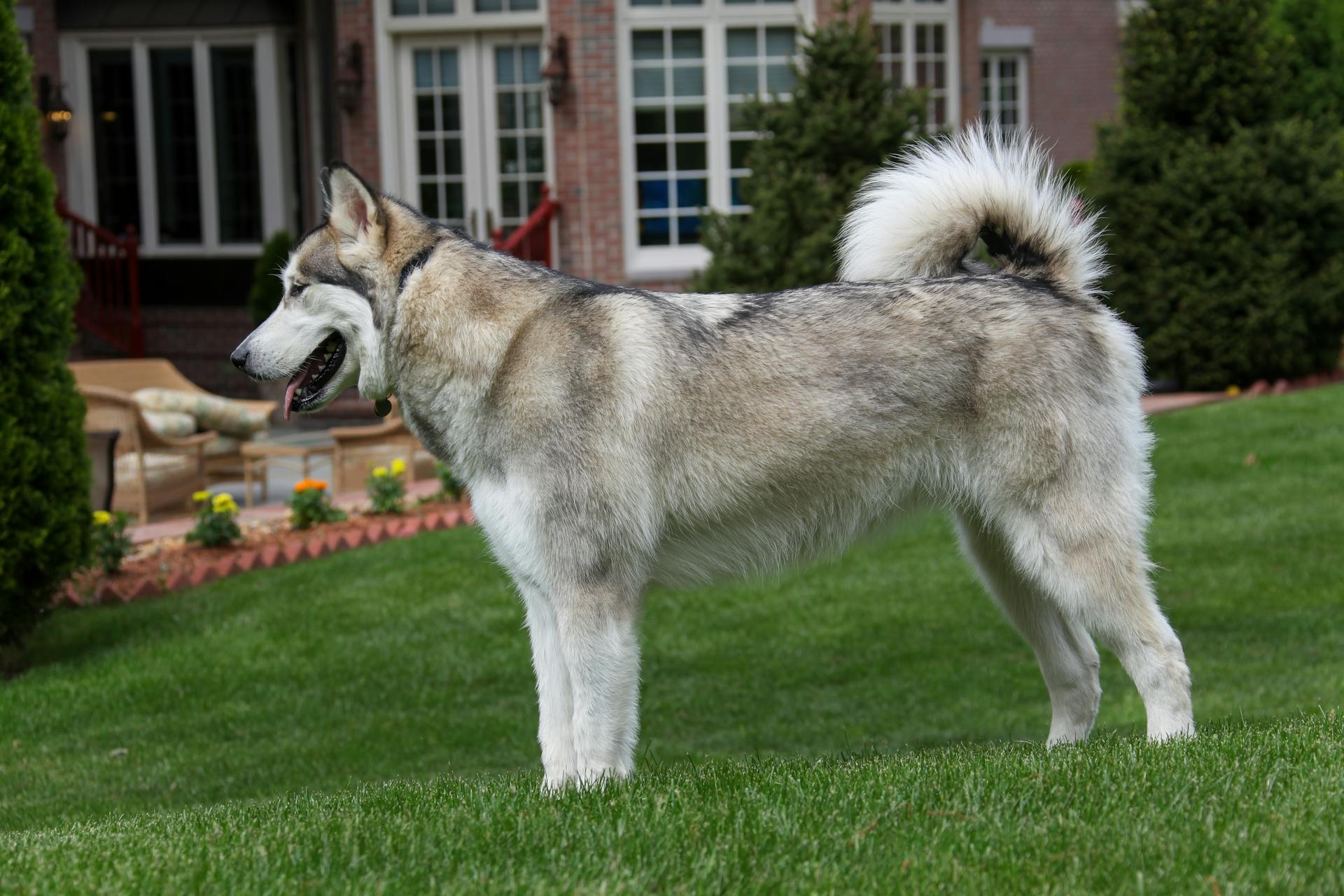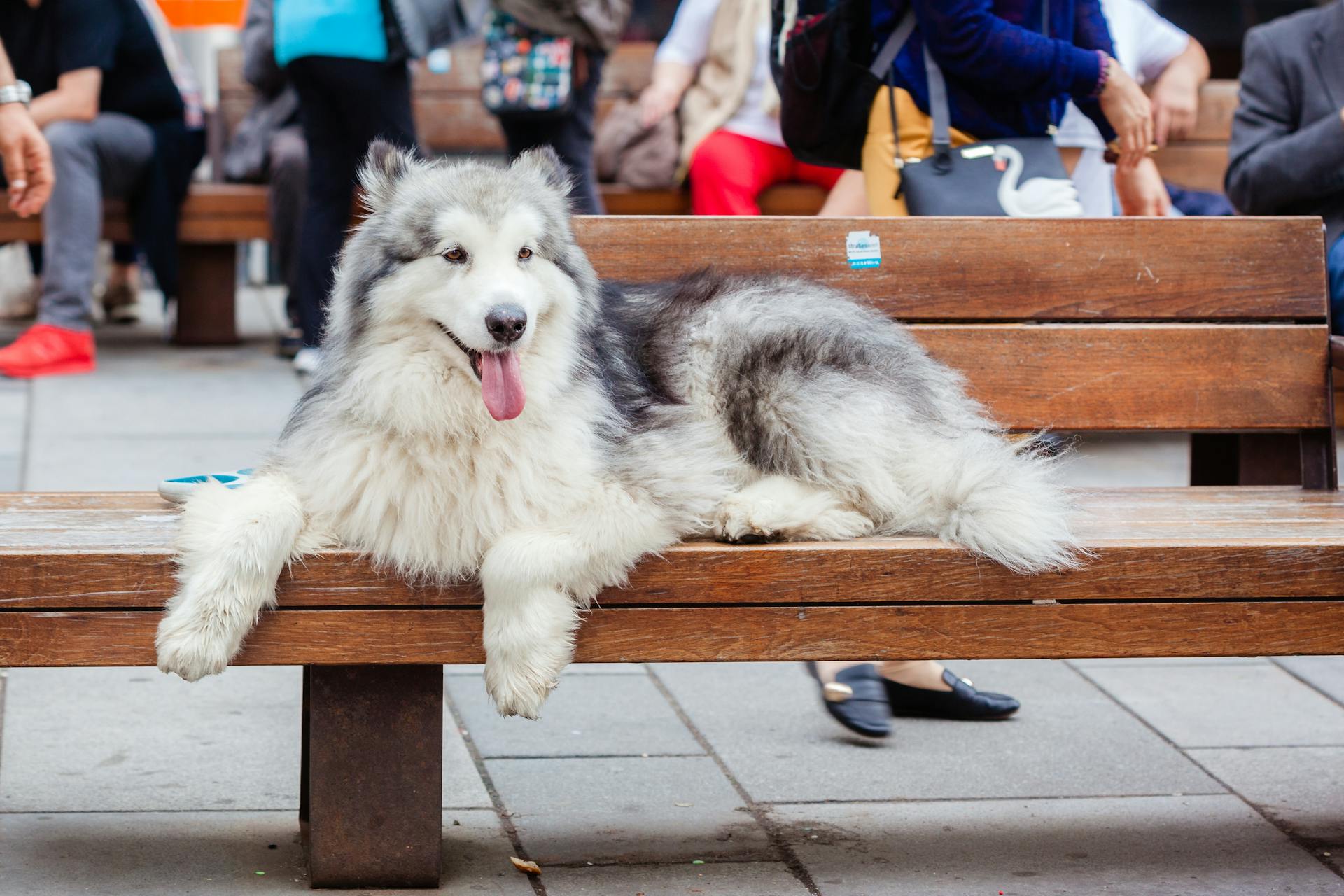
Welcoming an Alaskan Malamute puppy into your family is a thrilling experience, but it's essential to understand their unique needs and characteristics to ensure a happy and healthy life for both you and your new furry friend.
Alaskan Malamutes are a high-energy breed that requires regular exercise to stay happy and healthy. They need at least 1-2 hours of exercise per day, which can include walks, runs, and playtime in the yard.
As a breed, Alaskan Malamutes are prone to certain health issues, such as hip dysplasia and eye problems, so regular veterinary check-ups are crucial to catch any potential issues early on.
Consider reading: Are Alaskan Malamutes Good Guard Dogs
Your Health
As an Alaskan Malamute owner, you'll want to be aware of the potential health issues that can affect your furry friend. Cataracts, a clouding of the lens of the eye, can cause blindness and often appear between 1 and 2 years of age.
Hip dysplasia, a heritable condition, can lead to pain, lameness, and arthritis, and is a common issue in Malamutes. Regular check-ups with your veterinarian can help detect these problems early on.
Malamutes are prone to serious problems with their teeth, so brushing them at least three times a week is crucial to prevent dental issues. Regular grooming is also essential to maintain their coat health and minimize shedding.
Here are some common health conditions that can affect Alaskan Malamutes:
- Cataracts: Clouding of the lens of the eye that can cause blindness.
- Chondrodysplasia: Genetic disorder that causes dwarfism in dogs.
- Hip dysplasia: Heritable condition that can lead to pain, lameness, and arthritis.
- Hypothyroidism: Condition that occurs when the thyroid gland doesn't produce enough thyroid hormone.
- Hemeralopia (day blindness): Condition that causes dogs to be more sensitive to light.
- Polyneuropathy: Genetic disorder affecting the nervous system in canines.
By being aware of these potential health issues, you can take steps to prevent or detect them early on, ensuring your Alaskan Malamute lives a happy and healthy life.
Spaying and Breeding
Spaying or neutering an Alaskan Malamute puppy is a crucial decision that can have a significant impact on their health and behavior. Spaying or neutering can prevent certain health issues, such as uterine infections and testicular cancer.
Proper spaying or neutering can also reduce the risk of certain behaviors, like roaming and aggression, in intact Alaskan Malamutes.
Spay or Neuter
Spaying or neutering your Malamute is a crucial decision that can have a significant impact on their health and well-being. Spaying or neutering decreases the likelihood of certain types of cancers.
Performing this surgery also gives your vet a chance to identify and address some diseases your dog is likely to develop, such as needing hip X-rays or a puppy tooth extracted.
Breeding Restrictions
Breeding restrictions are in place to ensure the health and well-being of the animals involved. The Kennel Club has its own set of rules and regulations that may prevent a litter from being registered.
These rules and regulations can be found under the breeding restrictions section, where you can learn about general and breed-specific breeding restrictions. There are not currently any additional breed-specific restrictions in place for this breed, so you can focus on understanding the general rules.
The Kennel Club's rules and regulations are designed to prevent inbreeding and promote healthy breeding practices. By following these rules, you can help ensure the health and well-being of the animals in your care.
Take a look at this: American Kennel Club Lancashire Heeler
At Home
As you bring your Alaskan Malamute puppy home, it's essential to establish a routine that meets her energetic needs. Daily, vigorous exercise is essential to prevent boredom and destructive behavior.
Make sure to provide your puppy with long walks, hikes, and activities like dog sledding or weight pulling to help her expend her energy. This will also help her develop a strong work ethic.
A securely fenced yard is crucial to prevent your puppy from wandering, as they may have a strong prey drive. This will give you peace of mind and ensure her safety.
Regular grooming is vital to maintain your puppy's coat health and minimize shedding. Brush her at least a few times a week, and more frequently during heavy shedding seasons, to reduce loose fur and prevent matting.
You should also be aware of your puppy's need for temperature regulation. They can quickly overheat in hot temperatures, so never shave your Alaskan Malamute during the summer months.
Routine nail trimming, ear cleaning, and dental care are essential for your puppy's overall well-being. Keep an eye out for signs of ear infections and maintain oral hygiene to prevent dental issues.
Regular check-ups and vaccinations are also crucial for your puppy's health. Be sure to adhere to the schedule of examinations and vaccinations that your veterinarian recommends.
Emergencies
As a new Alaskan Malamute puppy owner, it's essential to know when your furry friend needs immediate veterinary attention. If you notice any of the following signs, seek medical care right away.
Scratching or shaking the head, tender ears, or ear discharge can be a sign of a serious ear infection.
Inability or straining to urinate, or discolored urine, may indicate a urinary tract issue.
Cloudiness, redness, itching, or any other abnormality involving the eyes can be a sign of a serious eye infection.
Leg stiffness, reluctance to rise, sit, use stairs, run, jump, or "bunny hopping" can be a sign of arthritis or other joint issues.
Dry heaving or a large, tight, painful abdomen can be a sign of gastrointestinal distress.
Dull coat, hair loss, sluggishness, and weight gain may indicate a nutritional imbalance or other underlying health issue.
Any abnormal shaking, trembling, or excessive involuntary tremors can be a sign of a neurological disorder.
Increased hunger and thirst, weight loss, can be a sign of diabetes or other metabolic disorders.
Straining to defecate, bleeding, licking of the area around the rectum, or smelly discharge may indicate gastrointestinal issues.
Dry, scaly, sometimes itchy hairless patches on face or paws can be a sign of skin allergies or conditions.
Bruises easily or bleeds a lot from a small wound can be a sign of a blood clotting disorder.
Coughing, exercise intolerance, rapid breathing at rest can be a sign of respiratory issues.
Here are some emergency signs to watch out for:
- Scratching or shaking the head, tender ears, or ear discharge
- Inability or straining to urinate; discolored urine
- Cloudiness, redness, itching, or any other abnormality involving the eyes
- Leg stiffness, reluctance to rise, sit, use stairs, run, jump, or “bunny hopping”
- Dry heaving or a large, tight, painful abdomen
- Dull coat, hair loss, sluggish, weight gain
- Any abnormal shaking, trembling, or excessive involuntary tremors
- Increased hunger and thirst, weight loss
- Straining to defecate, bleeding, licking of the area around the rectum, or smelly discharge
- Dry, scaly, sometimes itchy hairless patches on face or paws
- Bruises easily or bleeds a lot from a small wound
- Coughing, exercise intolerance, rapid breathing at rest
About This Breed
The Alaskan Malamute is a breed that's steeped in history and has been developed over thousands of years to be one of the strongest and most resilient sled dogs in the world.
They originated in Alaska, where they were used by the Mahlemut tribe to pull heavy loads over long distances, and their double coat protects them from extreme cold.
Their size is impressive, with males reaching up to 25 inches tall at the shoulder and weighing 85 pounds, while females are slightly smaller.
These gentle giants are built for endurance and can drag half a ton across challenging terrain for hundreds of miles.
Their distinctive tail is a hallmark of breed type and is often carried like a waving plume.
Here are some key facts about the Alaskan Malamute breed:
Their lifespan is relatively long, ranging from 10-14 years, and they require regular grooming to prevent matting of their thick, double coat.
Their temperament is loyal, affectionate, and playful, but they can be independent and stubborn at times.
Overall, the Alaskan Malamute is a breed that's well-suited to active families who can provide them with the exercise and attention they need.
Ownership and Lifestyle
As an Alaskan Malamute owner, you'll want to prioritize their routine care and exercise to ensure they live a long, happy life. Supervise your pet as you would a toddler, keeping doors closed and blocking off rooms as necessary to prevent mischief.
To keep your Mal's coat clean and healthy, brush them at least weekly, and be sure to brush their teeth at least three times a week to prevent serious problems. Clean their ears weekly, even as a puppy, to prevent infections.
A high-quality diet is essential for your Mal's overall health. Feed a consistent diet appropriate for their age, and avoid giving them people food. Exercise your dog regularly, but don't overdo it at first, as they have lots of energy and can get bored if they don't have enough physical and mental stimulation.
Care and Lifestyle
As a responsible Alaskan Malamute owner, you'll want to prioritize their care and lifestyle to ensure they live a happy and healthy life. Establish a routine care schedule to help your Malamute thrive, including regular brushing of their coat and teeth.
Supervise your pet as you would a toddler, keeping doors closed and picking up after yourself to prevent accidents. Brush their coat at least weekly, and their teeth at least three times a week to prevent serious problems. Clean their ears weekly to prevent infections.
A different take: Black Mouth Cur Teeth

Exercise is crucial for Alaskan Malamutes, who need daily, vigorous exercise to prevent boredom and destructive behavior. A securely fenced yard is essential to prevent wandering, as they may have a strong prey drive. You can also provide mental stimulation through puzzle toys and obedience training.
Alaskan Malamutes have a thick double coat designed to protect them from cold temperatures, but they can quickly overheat in hot temperatures. Never shave your Malamute during the summer months, as this can disrupt their ability to stay cool. Regular grooming is also crucial to maintain their coat health and minimize shedding.
Here's a summary of essential care tasks:
- Brush coat at least weekly
- Brush teeth at least three times a week
- Clean ears weekly
- Exercise daily, vigorously
- Groom regularly to maintain coat health
- Prevent overheating in hot temperatures
Alaskan Malamutes can live happily with children if well socialized from an early age, but it's essential to supervise interactions between dogs and young children.
Getting Started in Dog Sports
Getting started in dog sports can be an exciting but overwhelming experience, especially for first-time dog owners.
If you're new to dog sports, it's a good idea to start with an introduction to dog sports. This will give you a solid understanding of what to expect and help you decide which sport is right for you and your dog.
You don't have to have a purebred dog to participate in dog sports - mixed breed dogs are welcome and can be just as talented as their purebred counterparts. In fact, many dog sports organizations, like Canine Partners, actively encourage mixed breed participation.
Understanding the different titles and abbreviations used in dog sports can be confusing, but it's essential to know what they mean if you want to get involved. Take some time to learn about the various titles and abbreviations used in dog sports.
So, which dog sport should you do with your dog? It really depends on your dog's breed, age, and energy level, as well as your own interests and goals. Consider what you and your dog enjoy doing together and what you hope to achieve through dog sports.
If you're new to dog training, it's a good idea to start with the basics. Get started in dog training by learning the fundamentals of obedience, agility, and other dog sports. This will give you a solid foundation to build on and help you and your dog succeed in dog sports.
If you can't make it to a physical dog sports event, don't worry - there are plenty of virtual options available. Virtual dog sports and events are a great way to participate in dog sports from the comfort of your own home.
Curious to learn more? Check out: Lancashire Heeler News
Frequently Asked Questions
How much does a Malamute puppy cost?
The cost of an Alaskan Malamute puppy typically ranges from $1500 to $3000. Researching reputable breeders who prioritize their dogs' health is essential for finding a fair price.
Are Malamutes dog friendly?
Malamutes can be challenging to socialize with other dogs, especially small ones, due to their strong predatory instincts. They are best suited as an only dog or with experienced owners who can manage their interactions with other pets.
How big does a Malamute puppy get?
Malamute puppies typically grow to be around 23-25 inches tall and weigh 75-85 pounds as adults, with males slightly larger than females.
Are Alaskan Malamutes good house dogs?
Alaskan Malamutes can make great house dogs for active families, but they require gentle handling and early socialization to thrive in a home environment. With proper care, they can be a loving and loyal companion for families with children.
Is a Malamute bigger than a husky?
Malamutes are generally larger than huskies, weighing 70-85 pounds and standing over 2 feet tall, compared to the husky's 35-60 pounds and under 2 feet tall. This size difference is one of the key distinctions between the two breeds.
Sources
- https://www.oakdaleveterinarygroup.com/services/dogs/breeds/alaskan-malamute
- https://www.thekennelclub.org.uk/search/breeds-a-to-z/breeds/working/alaskan-malamute/
- https://www.akc.org/dog-breeds/alaskan-malamute/
- https://www.purina.co.uk/find-a-pet/dog-breeds/alaskan-malamute
- https://dogtime.com/dog-breeds/alaskan-malamute
Featured Images: pexels.com

